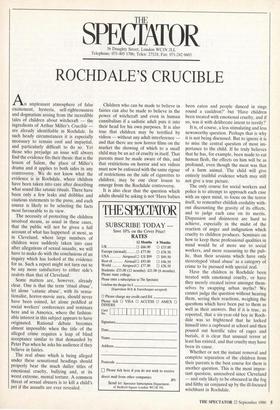ROCHDALE'S CRUCIBLE
An unpleasant atmosphere of false excitement, hysteria, self-righteousness and dogmatism arising from the incredible tales of children about witchcraft — the ingredients of Arthur Miller's Crucible — are already identifiable in Rochdale. In such heady circumstances it is especially necessary to remain cool and impartial, and particularly difficult to do so. Yet those who prejudge an issue will always find the evidence fits their thesis: that is the lesson of Salem, the place of Miller's drama and it applies to both sides in any controversy. We do not know what the evidence is in Rochdale, where children have been taken into care after describing what sound like satanic rituals. There have been only a few leaks and dribbles and cautious statements to the press, and each source is likely to be selecting the facts most favourable to its view.
The necessity of protecting the children involved means, as usual in these cases, that the public will not be given a full account of what has happened: at most, as in Cleveland, where large numbers of children were suddenly taken into care after allegations of sexual assaults, we will have to make do with the conclusions of an inquiry which has looked at the evidence for us. Such a report might not turn out to be any more satisfactory to either side's zealots than that of Cleveland.
Some matters are, however, already clear. One is that the term 'ritual abuse', let alone 'satanic abuse', with its sensa- tionalist, horror-movie aura, should never have been coined, let alone peddled at social workers' conferences and seminars here and in America, where the fashion- able interest in this subject appears to have originated. Rational debate becomes almost impossible when the title of the alleged crime requires a leap of blind acceptance similar to that demanded by Peter Pan when he asks his audience if they believe in fairies.
The real abuse which is being alleged under these sensational headings should properly bear the much duller titles of emotional cruelty, bullying and, at its worst extreme, mental torture. A common threat of sexual abusers is to kill a child's pet if the assaults are ever revealed. Children who can be made to believe in fairies can also be made to believe in the power of witchcraft and even in human cannibalism if a sadistic adult puts it into their head for his own purposes. It is also true that children may be terrified by videos — without any adult interference — and that there are now horror films on the market the showing of which to a small child may be an act of cruelty in itself. That parents must be made aware of this, and that restrictions on horror and sex videos must now be enforced with the same rigour of restrictions on the sale of cigarettes to children, may be one clear lesson to emerge from the Rochdale controversy.
It is also clear that the question which adults should be asking is not 'Have babies been eaten and people danced in rings round a cauldron?' but 'Have children been treated with emotional cruelty, and if so, was it with deliberate intent to terrify?'
It is, of course, a less stimulating and less newsworthy question. Perhaps that is why it is not being discussed. But to ignore it is to miss the central question of most im- portance to the child. If he truly believes that he has, for example, been made to eat human flesh, the effects on him will be as profound, even though the meat was that of a farm animal. The child will give entirely truthful evidence which may still not give a true picture.
The only course for social workers and police is to attempt to approach each case with an open mind, to focus on the terror itself, to remember childish credulity with- out discounting the gravity of its effects, and to judge each case on its merits. Dispassion and disinterest are hard to achieve, especially in the midst of the reaction of anger and indignation which cruelty to children produces. Seminars on how to keep these professional qualities in mind would be of more use to social workers, and more reassuring to the pub- lic, than their sessions which have only stereotyped 'ritual abuse' as a category of crime to be pursued with special zeal.
Have the children in Rochdale been treated with emotional cruelty, or have they merely created terror amongst them- selves by swapping urban myths? We cannot judge the question without hearing them, seeing their reactions, weighing the questions which have been put to them as well as their answers. But if it is true, as reported, that a six-year-old boy in Roch- dale was so frightened that he locked himself into a cupboard at school and then poured out horrific tales of cages and burials, it is clear that unusual terror at least has existed, and that cruelty may have been its cause.
Whether or not the instant removal and complete separation of the children from their parents is the best course for them is another question. This is the most impor- tant question, unresolved since Cleveland and only likely to be obscured in the fog and filthy air conjured up by the ill-focused witchhunt in Rochdale.


































































 Previous page
Previous page